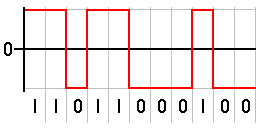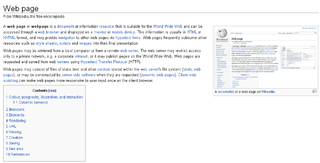The bit is the most basic unit of information in computing and digital communications. The name is a portmanteau of binary digit. The bit represents a logical state with one of two possible values. These values are most commonly represented as either "1" or "0", but other representations such as true/false, yes/no, on/off, or +/− are also widely used.
In communications and information processing, code is a system of rules to convert information—such as a letter, word, sound, image, or gesture—into another form, sometimes shortened or secret, for communication through a communication channel or storage in a storage medium. An early example is an invention of language, which enabled a person, through speech, to communicate what they thought, saw, heard, or felt to others. But speech limits the range of communication to the distance a voice can carry and limits the audience to those present when the speech is uttered. The invention of writing, which converted spoken language into visual symbols, extended the range of communication across space and time.

Cyberspace is a concept describing a widespread interconnected digital technology. "[The expression dates] from the first decade of the diffusion of the internet. It refers to the online world as a world 'apart,' as distinct from everyday reality. In cyberspace people can hide behind fake identities, as in the famous The New Yorker cartoon ..." The term entered popular culture from science fiction and the arts but is now used by technology strategists, security professionals, governments, military and industry leaders and entrepreneurs to describe the domain of the global technology environment, commonly defined as standing for the global network of interdependent information technology infrastructures, telecommunications networks and computer processing systems. Others consider cyberspace to be just a notional environment in which communication over computer networks occurs. The word became popular in the 1990s when the use of the Internet, networking, and digital communication were all growing dramatically; the term cyberspace was able to represent the many new ideas and phenomena that were emerging.

In telecommunication, a line code is a pattern of voltage, current, or photons used to represent digital data transmitted down a communication channel or written to a storage medium. This repertoire of signals is usually called a constrained code in data storage systems. Some signals are more prone to error than others as the physics of the communication channel or storage medium constrains the repertoire of signals that can be used reliably.

Free-space optical communication (FSO) is an optical communication technology that uses light propagating in free space to wirelessly transmit data for telecommunications or computer networking. "Free space" means air, outer space, vacuum, or something similar. This contrasts with using solids such as optical fiber cable.
DM, Dm, dm, or D.M. may stand for:

Wireless communication is the transfer of information (telecommunication) between two or more points without the use of an electrical conductor, optical fiber or other continuous guided medium for the transfer. The most common wireless technologies use radio waves. With radio waves, intended distances can be short, such as a few meters for Bluetooth or as far as millions of kilometers for deep-space radio communications. It encompasses various types of fixed, mobile, and portable applications, including two-way radios, cellular telephones, personal digital assistants (PDAs), and wireless networking. Other examples of applications of radio wireless technology include GPS units, garage door openers, wireless computer mouse, keyboards and headsets, headphones, radio receivers, satellite television, broadcast television and cordless telephones. Somewhat less common methods of achieving wireless communications involve other electromagnetic phenomena, such as light and magnetic or electric fields, or the use of sound.
Vector most often refers to:

Electronic media are media that use electronics or electromechanical means for the audience to access the content. This is in contrast to static media, which today are most often created digitally, but do not require electronics to be accessed by the end user in the printed form. The primary electronic media sources familiar to the general public are video recordings, audio recordings, multimedia presentations, slide presentations, CD-ROM and online content. Most new media are in the form of digital media. However, electronic media may be in either analogue electronics data or digital electronic data format.
An image is an artifact that depicts visual perception, such as a photograph or other two-dimensional picture.
The following are common definitions related to the machine vision field.

Timex Datalink or Timex Data Link is a line of early smartwatches manufactured by Timex and is considered a wristwatch computer. It is the first watch capable of downloading information wirelessly from a computer. As the name implies, datalink watches are capable of data transfer through linking with a computer. The Datalink line was introduced in 1994 and it was co-developed with Microsoft as a wearable alternative to mainstream PDAs with additional attributes such as water resistance, that PDAs lacked, and easy programmability. The watch was demonstrated by Bill Gates on 21 June 1994 in a presentation where he downloaded information from a computer monitor using bars of light and then showed to the audience the downloaded appointments and other data. The early models included models 50, 70, 150 and model 150s. The model numbers indicated the approximate number of phone numbers that could be stored in the watch memory. These early models were, at the time of their introduction, the only watches to bear the Microsoft logo. The watches have been certified by NASA for space travel and have been used by astronauts and cosmonauts in space missions. There had been an evolution over the years as to the number and type of entries that can be stored in the various watch models as well as the mode of data transfer between computer and watch. At the time of its introduction the watch was considered high-tech.
3-D,3D, or 3d may refer to:
Thunderbolt is the brand name of a hardware interface for the connection of external peripherals to a computer. It has been developed by Intel, in collaboration with Apple. It was initially marketed under the name Light Peak, and first sold as part of an end-user product on 24 February 2011.
This glossary of computer hardware terms is a list of definitions of terms and concepts related to computer hardware, i.e. the physical and structural components of computers, architectural issues, and peripheral devices.





